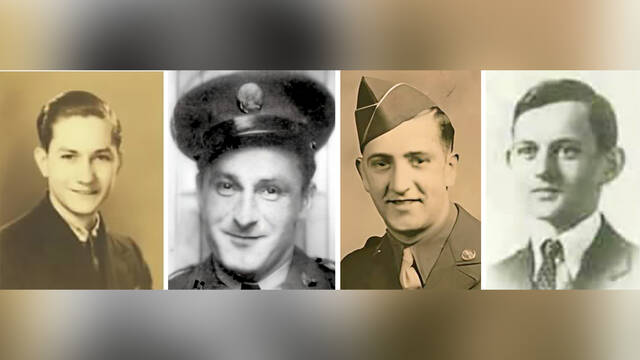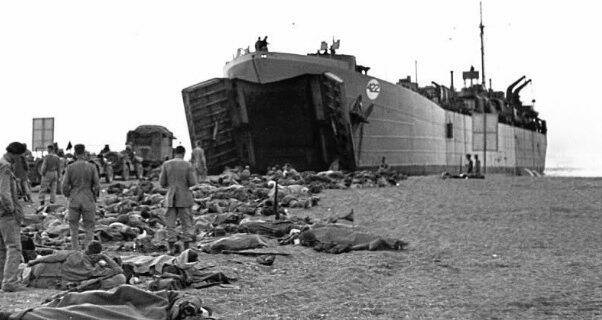Area fallen soldiers remembered 81 years after Allied landing craft sank off coast of Italy
When Allied forces landed on the Italian coast at Anzio 81 years ago, they began a four-month battle that left some 7,000 of their 100,000 troops dead.
That toll included 58 soldiers from the Keystone State — several residents of Westmoreland and Allegheny counties among them — who never made it ashore. They perished on Jan. 26, 1944 when their vessel struck a German mine and sank.
Members of the 83rd Chemical Mortar Battalion and the 68th Coast Artillery Regiment, they were aboard LST-422, one of 13 craft designated as Landing Ship, Tanks that sailed north together from Naples toward Anzio.
Area soldiers who died when the LST-422 sank have been memorialized online by the nonprofit national volunteer initiative Stories Behind the Stars.
The project’s name refers to the Gold Star families of fallen service members. It is dedicated to honoring all 421,000 fallen Americans from World War II, including 31,000 from Pennsylvania.
Area residents who were lost on LST-422 include:
PFC Joseph M. Donoghue, born April 3, 1922 at Pittsburgh to George Herbert and Hazel Vern Thompson Donoghue. Raised in Mt. Washington, he graduated from St. Justin’s High School and worked in architecture. He enlisted in the Army in Pittsburgh on Feb. 23, 1942. Two younger brothers also served in World War II — George Jr. in the Army and Edwin, who served in the Merchant Marines. Edwin died in France on March 23, 1945.
PFC Walter Leland Dunwiddie, Jr., born Aug. 12, 1922 at Portage, Cambria County, to Walter and Mary Sedonia Weaver Dunwiddie. He was raised in the Pittsburgh communities of Overbrook and Brentwood. He graduated from Carrick High School and became a shipping/receiving clerk for machinery supplier Somers, Fitler & Todd Co. in Pittsburgh. He married Helen Regina D. “Jean” Wilson in Pittsburgh on March 20, 1942. He enlisted in the Army at Pittsburgh on Sept. 25, 1942. He was hospitalized for four months with typhoid fever he contracted while participating in the North African and Sicilian campaigns. He never had the chance to hold his daughter, Claudia Lee, born on May 3, 1943, while he was overseas.
PFC John Flanick, born Dec. 27, 1914 in South Greensburg to Wanda and Mele Flanick, who emigrated from Austria in 1911. The family settled in Hempfield and included eight children. John Flanick was inducted into the Army on April 10, 1941, in Pittsburgh and was assigned to the 68th Coast Artillery Regiment.
TEC5 Michael Frankoff, born Oct. 31, 1917 at Elsworth, Washington County, to Russian immigrants Alex and Anna E. Frankoff. He was raised in Springdale and West Deer and completed two years of high school. He enlisted in the Army in December 1939 and was assigned to the 68th Coast Artillery Regiment.
PFC William James Geiger, born June 17, 1921 in Export to George W. and Margaret (Lindsay) Geiger, who was a native of Scotland. Geiger attended one year of high school and worked as a coal miner. He enlisted in the Army Air Force on Feb. 16, 1942 in Greensburg. His father served in both World War I and World War II and his younger brother, George, served in the Navy during World War II.
PFC Richard Kenneth Hill, born Dec. 17, 1920 in Hempfield to Jacob Pierce and Anna Mary Cline Hill. He was the youngest of nine children. Richard Hill enlisted in the Army at Greensburg on Sept. 25, 1942.
PFC Michael J. Rebick, born Nov. 15, 1921 in the Mt. Pleasant Township village of Trauger to Slovakian immigrants Andrew and Anna Tissak Rebick (or Hrebik). One of 10 children, he became a laborer in a slaughter house and enlisted in the Army in Greensburg on Sept. 25, 1942.
PVT John W. Revak, born June 9, 1918 in the Hazelwood neighborhood of Pittsburgh to Frank and Mary Bertha Revak, who emigrated from Hungary in 1901. He attended Duquesne schools through the eighth grade and worked for Carnegie-Illinois Steel Company at the Duquesne Works. He enlisted in the Army in Pittsburgh on Jan. 16, 1942. Three siblings also served in World War II — Frank as an Army corporal, Louis as a Navy petty officer and Margaret as a corporal in the Women’s Army Corps.
PFC Donald Rugito, born July 16, 1921 at Jeannette, the second son of Donato Antonio and Augusta Derenne Rugito. He graduated from Jeannette High School in 1939 and worked at Westinghouse Electric. He enlisted in the Army at Greensburg on Sept. 24, 1942. He was wounded by shrapnel in July 1943 during the invasion of Sicily.
PVT Carl Samuel Shoaf, born Oct. 9, 1921 at Greensburg to Elmer Jacob and Hazel M. Shoaf. One of five children, he enlisted in the Army at Greensburg on Sept. 25, 1942.
TEC4 John Stefanko, born in 1905 in Allegheny County to Pauline Stefanko. He enlisted in the Army in Pittsburgh on June 8, 1942.
All 11 posthumously received the Purple Heart.
Rebick was buried at the Sicily-Rome American Cemetery and Memorial in Nettuno, Italy. The others are memorialized there on the Tablets of the Missing.
Mine detonates cargo
The landing craft, though originating in Baltimore, was part of the Royal Navy fleet, transferred to the United Kingdom under the U.S. Lend-Lease Act. It was designed to carry up to 1,900 tons of cargo.
Rough seas and gale force winds pushed LST-422 into a German minefield, where a mine detonated the landing craft’s flammable cargo.
The ship was carrying vehicles, gasoline, a variety of ammunition and related volatile chemical equipment, according to an account based on a war diary and posted on navsource.org.
Mortars also were on board. The battalion operated batteries of 4.2-inch mortars that fired white phosphorus, smoke, gas and high explosive shells. Many trucks were loaded with volatile white phosphorus mortar shells.
According to navsource.org, the mine explosion “tore a hole through the bottom and starboard side of the ship. Fire rapidly spread as the gasoline and chemicals on deck were ignited.
“As the ship flooded and continued to burn, orders were given to abandon ship. Rough seas complicated rescue attempts by nearby vessels, and many crew members were lost in the frigid waters as the ship broke in two and sank.”
The sinking represented the greatest single-day loss of life in the 100-year history of the Army’s Chemical Corps, according to a Facebook post by the the U.S. Army Chemical, Biological, Radiological and Nuclear School.
The mine blast and sinking claimed 289 members of the battalion.
Burning 55-gallon drums of fuel triggered additional explosions of the mortar ammunition.
Vehicles that were secured on decks became dislodged and pinned soldiers.
According to the school’s post, “The fire and explosions trapped most of the Chemical soldiers below deck, unable to escape as the ship burned and sank. Sadly, most of the bodies of those lost were never recovered.”
An account of the sinking on a Camden, N.J. history website indicates most of the battalion soldiers were asleep in the ship’s tank deck, which was the first to flood after the 5:20 a.m. mine blast.
The vessel’s landing craft was ablaze and fell into the sea, leaving only four undamaged life rafts for those who had abandoned ship. Many who took to the water died in the frigid sea.
A U.S. Navy landing craft, LCI-32, headed to the rescue but also hit a mine and sunk — resulting in 30 of its crew members lost and 11 wounded.
Several minesweeper vessels combined efforts to rescue 150 survivors from the two sunken craft.
All told, 454 Americans and 29 British sailors were lost on the LST-422.
Unveiled in November 2022, a memorial brick-way pays tribute to the Chemical units’ lost soldiers in a Memorial Grove at Fort Leonard Wood, Mo.
Of the fallen in the incident who were recovered, 54 were interred in U.S. military cemeteries in Italy and 37 were buried at sea. Another 362 weren’t recovered or identified.
The Anzio landings, also known as Operation Shingle, didn’t result in a rapid advance to Rome, as Allied leaders had hoped. But they were an important step toward the eventual Allied victory in World War II’s European Theater.
The American Battle Monuments Commission notes that the Anzio landings “served as an important predecessor to the more famous D-Day landings in Normandy that occurred only two days after the fall of Rome.
”The landings at Anzio drew in German reinforcements from across Europe, weakening the garrison that was to defend northern France. The long and bloody Allied campaign that liberated Italy also contributed to the success of campaigns elsewhere in Europe.”
Jeff Himler is a TribLive reporter covering Greater Latrobe, Ligonier Valley, Mt. Pleasant Area and Derry Area school districts and their communities. He also reports on transportation issues. A journalist for more than three decades, he enjoys delving into local history. He can be reached at jhimler@triblive.com.
Remove the ads from your TribLIVE reading experience but still support the journalists who create the content with TribLIVE Ad-Free.


